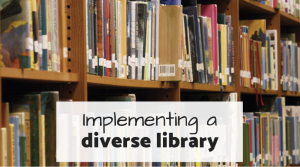New year, new goals! If one of your professional goals this year is to add more diversity to your school or classroom library, we’re here with some inspiration to get you started. In the following blog post, originally posted at the Center for the Collaborative Classroom and cross-posted with permission, our Director of Curriculum and Literacy Strategy Jill Eisenberg shares tips and suggestions for how to move forward without becoming overwhelmed:
In the last blog post, we explored how to go about developing and implementing diverse libraries at your school.
Schools and districts are doing some amazing work, but let’s face it: Roadblocks are inevitable.
“Obstacles don’t have to stop you. If you run into a wall, don’t turn around and give up. Figure out how to climb it, go through it, or work around it.” – Michael Jordan
What are the challenges in building or refreshing your diverse library? How do we overcome the challenges?
- Budget—Knowing the gaps in your library is your secret weapon. Your budget (or lack of budget) may mean you have to build or refresh your library in pieces, but starting with an assessment of your current collection will let you know what you need most. You can also look for grants, make wish lists, crowd fund, and focus on small parts of your library.
- Backlash– “One man can be a crucial ingredient on a team, but one man cannot make a team.” – Kareem Abdul-Jabbar. Some colleagues and parents might challenge the books or assert, “we don’t need those ” All of our children’s stakeholders must be part of the conversation and part of your strategy to bring culturally responsive and relevant resources into the classroom.

- Make the case that window opportunities are just as important as mirror opportunities. I strongly recommend reading this parent’s, these educators’, and this librarian’s case to fight the backlash and educate our colleagues.
- Consider creating a wish list or recommendation list where parents and students can nominate titles for you to consider adding to the collection (this can also be shared with parents for gifting or donating to the classroom).
- If parents or colleagues are fearful or feel threatened by particular subjects or titles, consider working with your administrators to find trainings or host a parents’ night to learn more.
- On a longer time horizon, consider working with the PTA/PTO to create a diversity and inclusion advisory panel.
- I’m struggling on where to find diverse books—You are right; it IS hard to find diverse books. See the infographic. On top of that, search engines, online retailers, and visual pinning platforms are overwhelming and can show you lists of books that aren’t from the experts. Here’s where to look.
- What does “done” look like? If you feel like this work is never done, you are right—it isn’t and won’t be. Adding culturally responsive and relevant titles to your collection is an ongoing process—there is keeping up with cultural changes and progress, responding to collective moments and current events, discovering ever new offerings, the adoption of new learning standards, and keeping up with shifting demographics in your classroom and community. Your new mantra: Your library is a journey, not a destination. How to keep up, stay sane, and stay within your budget:
- Look at your district’s and school’s enrollment for demographic insights for your classroom libraries’ needs. What once was a window book for your students, may now be a mirror book (and vice versa). What languages, religions, learning differences, and nationalities are you seeing that may be weren’t as predominant ten years ago?
- Aim for a periodic review with the classroom library questionnaire every couple of years.
- Remember that village of experts we talked about last week? Follow them on social media. I’ve found enewsletters in particular to be a manageable way to help cut through the noise and curate the most timely, relevant, and best resources. Don’t track new award winners, new trends, new lens for thinking about community conventions, genres, and standards updates all by yourself!
Why does this matter?
Schools and districts across the country are doing this hard work of creating and improving their culturally responsive and relevant books and libraries year after year because they know three things.
Diverse classroom libraries:
- Improve inclusivity and build community. You are showing our children that their experiences and values matter in your classroom and that there are many people and cultures to learn from. Let’s inspire and empower our students and their families to create a better world—starting with books.
- Improve reading engagement. Check out Reading Rockets for teacher practices that impact reading motivation.
- Improve reading outcomes. Remember, nationwide 63% of all 4th graders and 64% of all 8th graders are reading below grade level. We.must.do.better. Emerging evidence shows “black and Latino students enrolled in courses featuring culturally relevant themes and texts increased GPA in all courses, attendance, and credit accumulation.”
––––––
Jill Eisenberg is the Director of Curriculum and Literacy Strategy at LEE & LOW BOOKS, the largest independent children’s book publisher specializing in diversity and multiculturalism. Before joining LEE & LOW, Eisenberg was a Fulbright Fellow in Taiwan where she taught English as a foreign language to grades 2–6. She went on to become an ELA teacher for third grade in the Bay Area in California and has been passionate about best practices for supporting English Language Learners and parent engagement ever since. At LEE & LOW BOOKS, she oversees strategic partnerships and provides product and literacy expertise to schools, districts, and literacy organizations.









